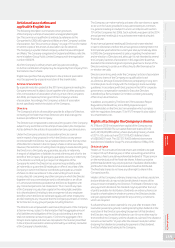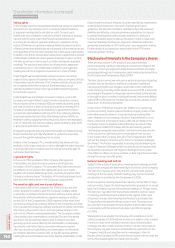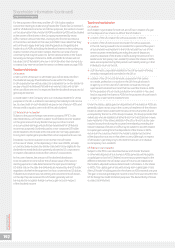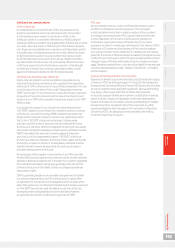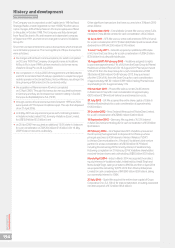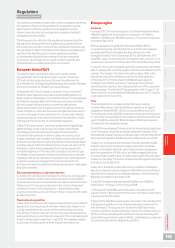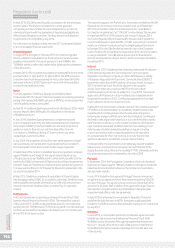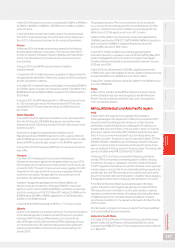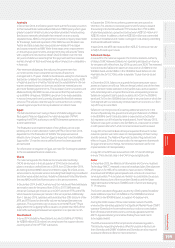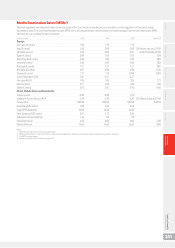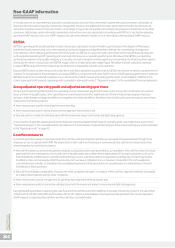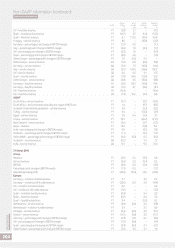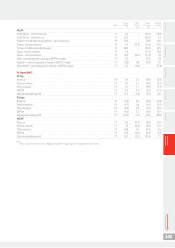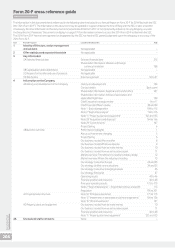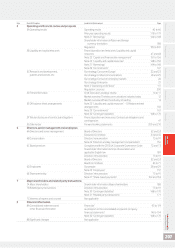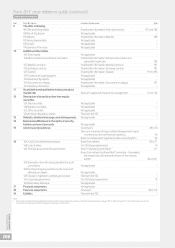Vodafone 2015 Annual Report Download - page 201
Download and view the complete annual report
Please find page 201 of the 2015 Vodafone annual report below. You can navigate through the pages in the report by either clicking on the pages listed below, or by using the keyword search tool below to find specific information within the annual report.
Australia
In December 2014, the federal government put the nal policy touches
to their revised National Broadband Network (‘NBN’) policy which gives
greater scope for infrastructure competition provided those investing
xed access networks wholesale their network on a structurally
separated basis. NBN Co, the government-owned company responsible
for the design, build and operation of the NBN, has also nalised new
Telstra and Optus deals that now passes ownership of the copper
and coaxial networks to NBN. While these steps are an improvement
on the previous government’s arrangements they still provide Telstra
with a signicant new revenue stream (AUD 20 billion over the next
ten years). Vodafone is asserting that this payment and the increased
market strength of Telstra will have signicant impacts on competition
in Australia.
After extensive lobbying by the industry, the government has
commenced the most comprehensive review of spectrum
management in 15 years. Vodafone Australia are asking for a framework
that better considers the competition effects of spectrum policy (60%
of regional spectrum is held by Telstra) and the establishment of more
market orientated spectrum licences and a better renewal process
and more exible payment terms. The Australian Communications and
Media Authority (‘ACMA’) has also announced that they will auction
up to 60MHz of regional 1800MHz spectrum to be made available
in two to three years’ time (currently allocated for xed link wireless
services). This will also clear the way for some portions of currently
unused regional spectrum to be provided on an interim basis.
Egypt
The Administrative Court ruling in favour of Vodafone Egypt’s case
led against Telecom Egypt and the national regulator (‘NTRA’)
regarding the NTRA’s authority to set MTRs between operators is yet
to be implemented.
The nalisation and implementation of the Unied Licence is still
pending and is, under a decision made by NTRA in December 2014,
dependent on the nalisation of ‘KAYAN’, the proposed second
infrastructure company. Telecom Egypt is expected to exit Vodafone
Egypt within 12 months once a unied licence has been approved
and activated.
For information on litigation in Egypt, see note 30 “Contingent liabilities”
to the consolidated nancial statements.
Ghana
The national regulator, the National Communication Authority
(‘NCA’) announced in the last quarter of 2014, that in line with its
plans to introduce unied licences in 2019, from 23 December 2014,
all existing licensed MNOs became entitled to apply for a xed access
service licence, to provide services including xed telephony, broadband
and other value added services. Vodafone Ghana and Airtel Ghana were
the only MNOs with xed licences prior to this announcement.
In December 2014, the NCA announced the mobile and xed wholesale
termination rates for the period from 2015 to 2017. SMS rates will
remain at 5 peswas per minute up until 2017 and both FTRs and MTRs
will increase to 6 peswas per minute in the same period. Additionally,
from 1 January 2016, operators will be entitled to a 20% discount of the
MTR and FTR based on the trafc volume exchanged between two
operators. The asymmetric rate or discount on the MTR and FTR will
apply where the outgoing trafc is equal to or greater than 60% of the
total trafc exchanged between two operators in a calendar month.
New Zealand
In June 2014, Vodafone New Zealand secured 2x15MHz of 700MHz
for NZ$68 million (£35 million), securing blocks that support devices
covering both of the “APT700” sub-bands.
In September 2014, the incumbent government announced its
intention, if re-elected, to increase government funding to expand
the existing Ultra-fast Broadband FTTP initiative from 75% to 80%
of premises passed at a projected cost between NZ$152 million and
NZ$210 million. In addition, a further NZ$150 million was committed
to improve broadband and mobile coverage in rural areas by extending
the Rural Broadband Initiative.
In April 2014, the MTR rate reduced from NZ$ 3.72 cents per minute
to NZ$ 3.56 cents per minute.
Safaricom: Kenya
In June 2014, the national regulator, the Communications Authority
of Kenya (‘CAK’) renewed Safaricom’s operating and spectrum licence
for ten years with effect from July 2014 up until June 2024. The renewed
licence includes Safaricom’s spectrum resources in 2x10MHz in the
900MHz band and 2x10MHz in the 1800MHz band. Safaricom still
maintains the 2x10 2.1GHz under a separate 15 year licence issued
in 2007.
In December 2014, Safaricom acquired the base transceiver station
assets and spectrum of Essar Telecom Kenya Limited, one of the three
other licensed mobile operators in Kenya (this was a joint acquisition
with Airtel Kenya who acquired the business and operating licences).
Safaricom acquired Essar’s spectrum assets of 2x7.5 in the 900MHz
band and 2x10 in the 1800MHz band under a ten year licence which the
CAK aligned with our previously renewed spectrum licence to run from
July 2014 up to June 2024.
Safaricom is in the process of acquiring additional spectrum in the
4G band. Specically, the government will grant Safaricom 2x15MHz
in the 800MHz band ( total allocation is expected to be 2x20 after
full migration out of the band by broadcasters). From February 2015,
Safaricom was given access to the 2x15MHz on a trial basis for a three
month period, after which a full commercial licence will be issued.
In July 2014, the Central Bank of Kenya requested that each mobile
network operator submit its views on interoperability of their money
transfer services. The National Payment Systems Regulations took
effect in August 2014 and now provides the management framework
for payment services in Kenya. No timelines have been set for the
implementation of interoperability.
In July 2014, the MTR was reduced from KES 1.15 to KES 0.99 per
minute. This is the last step in the CAK’s imposed glide-path.
Qatar
In December 2013, the Ministry of Information and Communications
Technology (‘MICT’) released a national broadband plan. One objective
of the plan, is for 98% of households to have access to 100 Mbps
download and 50 Mbps upload speeds and a choice of at least two
service providers. This includes an intention to consolidate the access
network infrastructure of the incumbent Ooredoo and the Qatar
National Broadband Network (‘QNBN’), both of which are deploying
FTTP networks.
The Communications Regulatory Authority (‘CRA’) granted Vodafone
Qatar additional spectrum of 2x5MHz in the 1800MHz band and
2x10MHz in the 800MHz band, to support 4G deployment.
During the CRA’s review of three retail mobile markets, the CRA
amended the remedies applied to the Signicant Market Power (‘SMP’)
operator (Ooredoo) in those markets without notice or consultation.
Both of these amendments were successfully appealed with the
MICT’s Appeals Advisory Committee nding the amendments
to be legally invalid.
The CRA announced a shift in emphasis to wholesale regulation.
This includes requesting reference offers for passive infrastructure
from Ooredoo and QNBN. Vodafone and Ooredoo are also required
to prepare reference offers for interconnection.
Overview Strategy review Performance Governance Financials Additional
information Vodafone Group Plc
Annual Report 2015
199


